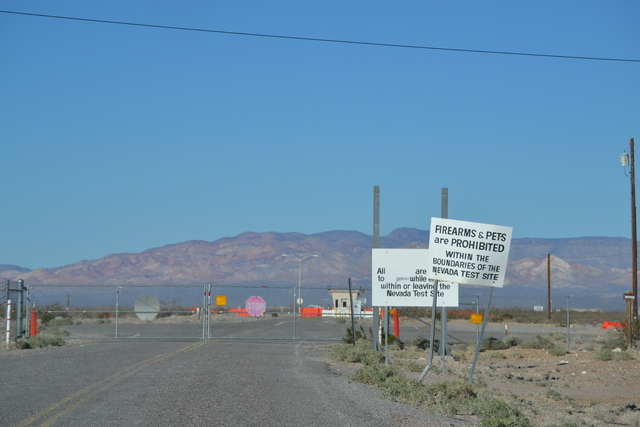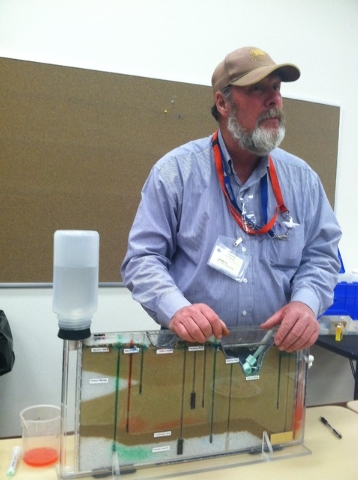Test site contamination creeping toward area drinking groundwater
Declining aquifer levels and increased pumping in southern Nye County could cause test site water contaminated by nuclear testing to flow more quickly toward groundwater used for drinking, warned officials.
However, a Department of Energy official said the water is currently safe to drink.
Contaminated water from the Frenchman Flat area of the site is traveling at a very slow rate, about three feet per year, toward the Amargosa Valley. At that rate of speed, it would take a “very, very long time” for contaminated water to reach Amargosa, according to Department of Energy Geologist Bill Wilborn.
However, the contaminated water from Pahute Mesa is moving at a more rapid pace of 50-to-100 feet per year, toward Beatty. The contaminated water, Wilborn asserts, remains within the boundaries of federal land. Though the study and projections are not complete, Wilborn said preliminary information suggests that the contamination will not move off federal lands for approximately 100 years.
Federal energy officials co-sponsored an open house in Beatty on Feb. 18, to share the results of data collection which reflect how quickly contaminated water is moving off the Nevada National Security Site.
Wilborn said that the Department of Energy is not taking action to reduce the rates at which contaminated water is flowing off the site or federal lands. Instead, he said, the department is trying to understand where the nucleoides are migrating and how fast they are getting there. The collected data, which includes water samples from various test wells, will be put into a model which will help with that task.
Modeling, though, presents some troublesome issues.
“There are uncertainties, of course,” Wilborn said of the process. Ultimately, he said the goal is to demonstrate “long-term safety for the public.”
Wilborn says that water from the site is safe to drink, as long as it is not taken in proximity to where the nuclear testing occurred. Likewise, he said, there is no nuclear contamination from the site to Amargosa or Pahrump valley groundwater.
Though the contaminated water from the site flows toward Amargosa and Pahrump, it structurally by-passes Pahrump, Wilborn said. “The recharge for Pahrump is from the Spring Mountains, so there is not a lot of infiltration from the south (portion of the site) into Pahrump,” he said.
Wilborn said there is no correlation between declining aquifer levels in the Amargosa and Pahrump valleys and the rate of which contaminated water is flowing off the former test site. However, he was quick to add, if 12,000 acre feet of water were to be pumped in Beatty, it would change the rate of flow, or migration, of contaminated and noncontaminated water off the site.
Concerns about declining aquifer levels, as well as over-allocation of water rights in the Pahrump Basin by the state water engineer, have led Nye County geoscientists John Klenke and Levi Kryder to begin a monitoring program of their own. Over the past 15 years, 147 wells in the area have been measured for level changes. Eleven of the 147 wells were drilled with funding provided by the Department of Energy.
The data collected from the measuring program will be used to create a model that will help county planners simulate impacts to the water from population growth and development.
In contrast to Wilborn’s statement, Klenke said if the water levels in Pahrump or Amargosa dropped enough, it would cause the gradient to change, which, in turn, could cause water to move off the site at a faster rate.
Wilborn did not appear concerned with over-pumping in Amargosa Valley. Restrictions on pumping exist in the Amargosa region, he said, because its water system is connected to source water for Devil’s Hole, which is federally protected to keep water levels constant to protect endangered pupfish.
Though contamination of water is not his area of expertise, Klenke said that because of the nuclear testing in the 1950s, tritium can be found everywhere in the environment - in the air and in domestic wells.
Decisions about water usage and safety, based on the study, will not be made by the Department of Energy. Instead, Wilborn said, the state water engineer is charged with that task. Nor is the data from the ongoing study shared with the state water engineer, Wilborn said. However, it is made available to the public.
Of threats to water in Pahrump, Amargosa and Beatty, Wilborn said, “There is no impact to the public in the groundwater system from the testing. The groundwater is actually of very high quality and safe from nuclear testing. You are absolutely safe.”
Wilborn said that testing north of Beatty up to Pahute Mesa will continue until 2030.
Between 1951 and 1992, approximately 828 underground nuclear detonations occurred within a couple of hundred feet of the underground water table. More than 200 detonations occurred within or very close to the water table.
Although there are 43 nucleoides produced from nuclear testing considered to pose health risks at certain levels, the one commonly studied and tested for at the site is tritium.
The presence of tritium suggests the presence of other nuclear contaminants including carbon, iodine, chlorine, technetium, plutonium, cesium and strontium.
Tritium contamination was first detected off-site in 2009, traced to Pahute Mesa in the site’s northwest corner.


















